Editorial style guidelines for Coastal Carolina University
Updated Jan. 28, 2021
Coastal Carolina University’s Office of University Marketing and Communication uses a combination of AP style and Coastal Carolina University writing style when writing and editing all University materials.
In media releases, public service announcements and other public statements, we observe the editorial style rules of The Associated Press (AP) Stylebook as closely as possible. AP style is used as a basic guide for the editorial content of all materials produced by the University for external audiences, although exceptions are made depending on the nature and requirements of the piece.
There are some style guidelines and rules listed here that are unique to CCU and may be different than what is listed in the AP Stylebook. Those unique rules are decided upon by University Marketing and Communication and incorporated into our University writing style.
The following list is intended to provide guidance in the preparation of written materials prior to sending the materials to MarComm for proofing. This guide is updated as new questions arise. For any style questions, email editor@coastal.edu or call 349-2087.
acronyms — Organization names should be spelled out on first reference followed by the acronym in parentheses.
Example: Women in Philanthropy and Leadership (WIPL). Subsequent references should be restricted to the acronym only.
active voice — When writing copy, write in active voice consistently. This means using active verbs rather than speaking in past tense.
academic and administrative titles — Capitalize and spell out formal titles when they precede a name; however, put titles after a name in most cases. Lowercase elsewhere.
Examples: Roy Talbert, professor of history (preferred); Professor Roy Talbert (not wrong); history professor Roy Talbert; Karen Aguirre, associate professor of biology; Claudia Bornholdt, dean of the Thomas W. and Robin W. Edwards College of Humanities and Fine Arts; Dean Claudia Bornholdt.
Exception: Named and endowed chairs and professorships are always capitalized. Example: Sara Sanders, Kearns Palmetto Professor and professor of English at Coastal Carolina University.
Note: Only individuals with an M.D. are referred to as Dr. and then only on first reference. People with Ph.D.s or Ed.D.s are not referred to as Dr. If mention of degrees is necessary, place the degree after the name, set off by a comma: Pamela Martin, Ph.D.
academic degrees — The preferred style is bachelor’s degree; master’s degree. When the formal degree (e.g., Bachelor of Arts degree, Master of Science degree) is used, it should be capitalized as indicated with no possessive apostrophe. When abbreviating formal degree names, use periods after the letters (B.A., B.S., Ph.D., Ed.S., M.F.A., B.F.A.) with the exception of the MBA (no periods). Also, associate degree is not possessive.
Examples: Ph.D. Ed.D. Psy.D. LL.D. Ed.S.
Majors, minors, and subjects are lowercase except for languages. Examples: This semester, she is taking history, calculus, English and Spanish.
When writing out an academic degree or academic program, capitalize “Bachelor of _____” or “Master of _____,” then lowercase the subject matter after.
Example: Bachelor of Science in journalism.
If you are using the academic degree name in-full as a header for a document or graphic piece, it may all be capitalized. If you’re writing the name of an official program, it may be capitalized as well.
Example: The Master of Arts in Writing program.
academic departments — Capitalize when using the full, formal name of a department. This is the preferred form. Lowercase other forms. Example: the Department of History; the Department of Marine Science; the history department; the marine science department.
advisor — Not adviser. Previously, adviser was preferred, but we have since changed our University branding guidelines to adhere to industry standards.
alumni — Singular: alumnus; plural, alumni; singular female: alumna; plural female: alumnae. Do not use alum.
#TealTip: Concerning those who have graduated from #CCU -
alumnus - male #Chant
alumna - female #Chant
alumni - multiple #Chants
ampersand — Avoid using the ampersand in titles of organizations, departments, etc.
Exception: Burroughs & Chapin Center for Marine and Wetland Studies.
Atheneum — Coastal Carolina University’s symbol, a reference to the Temple of Athena (goddess of knowledge) in ancient Greece, is spelled with only one “a.”
Exception: The Athenaeum Press.
Department of Athletics — This is the official name for the department that oversees athletics at Coastal Carolina University and should be used upon first reference. Coastal Carolina Athletics, Chanticleer Athletics, and CCU Athletics are acceptable on second and subsequent references.
board of trustees — Lowercase. Exceptions include commencement programs and official invitations from the Office of the President.
board of visitors — Lowercase. Exceptions include commencement programs and official invitations from the Office of the President.
boardroom — Always one word.
buildings — On first reference, use the full name of the buildings that house the University’s four colleges. Example: E. Craig Wall Sr. College of Business Administration Building or Thomas W. and Robin W. Edwards College of Humanities and Fine Arts Building. On subsequent references: Wall Building or Edwards Building. Also, the Spadoni College of Education is located in the Prince Building. See also: colleges.
When referencing the student union, use the Lib Jackson Student Union on first reference and the Jackson Student Union or student union on subsequent references.
The hospitality area located on the third level of Brooks Stadium is the Kline Hospitality Suite.
The hospitality areas located on the second level of the HTC Center are the LeForce Suite and the Springs Suite.
bulleted lists — When listing things with bullets, put a space between the bullet and the first word of each item in the list. Capitalize the first word following the bullet. Use periods, not semicolons, at the end of each section, whether it is a full sentence or a phrase. If the bullet contains one or two words, omit the period. Use parallel construction for each item in a list:
- Start with the same part of speech for each item (in this example, a verb).
- Use the same voice (active or passive) for each item.
- Use the same verb tense for each item.
- Use the same sentence type (statement, question, exclamation) for each item.
- Use just a phrase for each item, if desired.
Introduce the list with a short phrase or sentence. Example: Our partners: or These are our partners:
business cards — The Office of University Marketing and Communication has standards and guidelines in place for all University business cards designed and printed by the print shop, including those for students and members of the Department of Athletics. Room numbers are not permitted on business cards, nor are personal websites, social media handles or email addresses. The design and text follows the templates below, with no exceptions
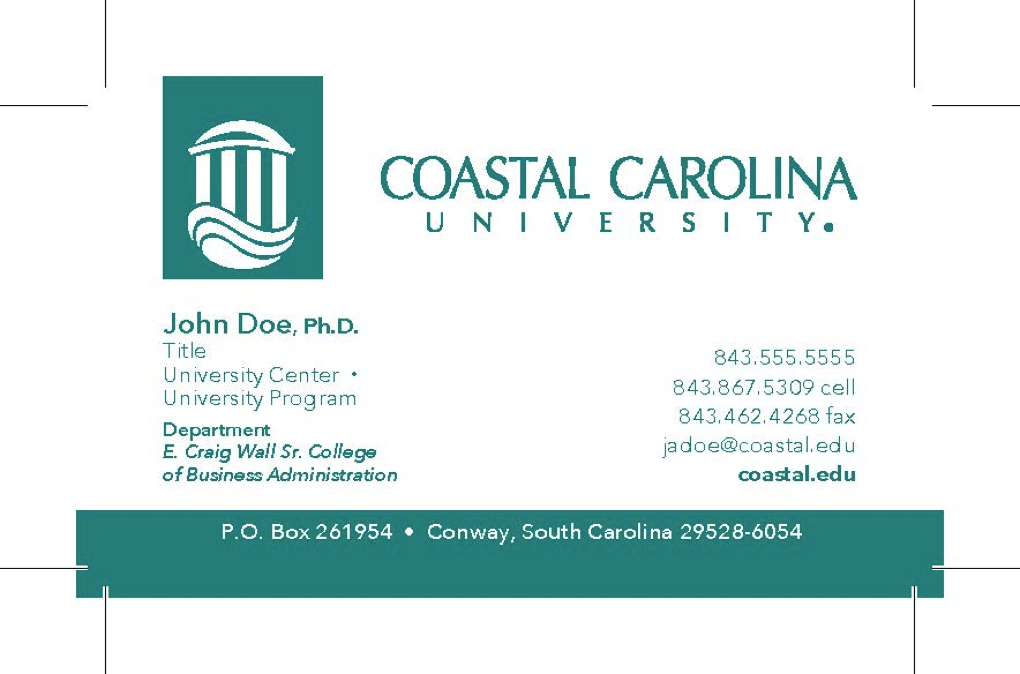
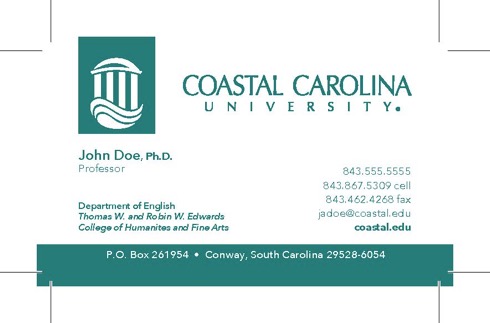
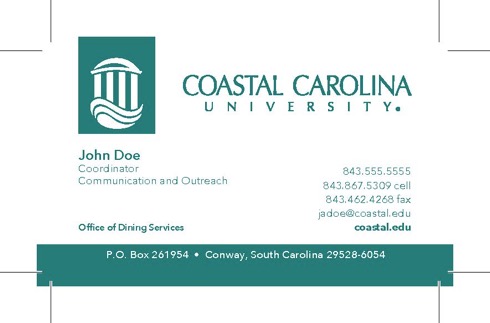
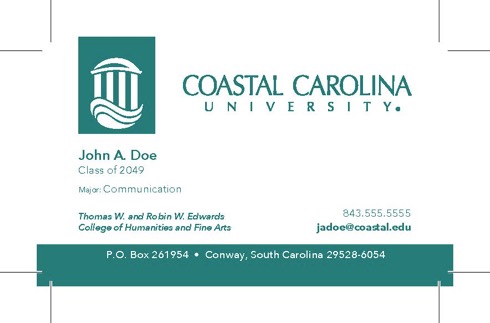
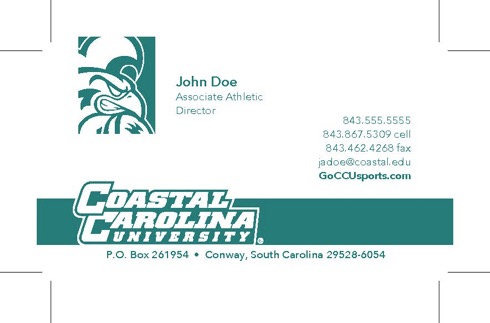
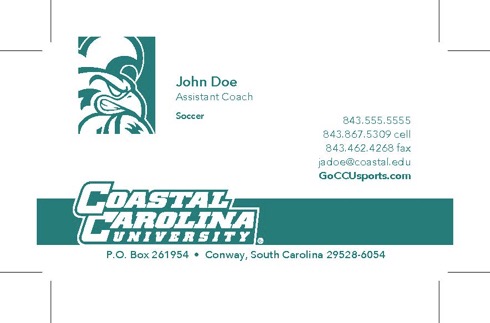
cellphone — Always one word.
chairman/chair — Use chairman or chair, not chairperson.
Chauncey — Abbreviated nickname for Coastal Carolina University’s mascot, the Chanticleer. Pronounced “CHAUN-see” and “SHON-TI-CLEER.”
Coastal Carolina University — Use all three words on first reference. On second and subsequent references, use CCU or Coastal Carolina or the University. Refrain from referring to the University as Coastal.
In communications from the Department of Athletics, “Coastal Carolina” may be used on second reference, and “Coastal” may be used thereafter. See Department of Athletics.
colleges — Use full name on first reference. Abbreviate subsequent references.
Examples:
First reference: Thomas W. and Robin W. Edwards College of Humanities and Fine Arts
Subsequent references: Edwards College of Humanities and Fine Arts
First reference: E. Craig Wall Sr. College of Business Administration
Subsequent references: Wall College of Business
Spadoni College of Education (no abbreviated form)
Gupta College of Science (no abbreviated form)
HTC Honors College and Center for Interdisciplinary Studies (no abbreviated form)
commas — Use an Oxford comma before the conjunction in a simple series. Examples: The flag is red, white, and blue. He would nominate Tom, Dick, or Harry.
Use an Oxford comma in departmental and office names. Example: Department of Communication, Media, and Culture.
Use a comma to separate cities and states. Example: He drove from Columbia, S.C., to Washington, D.C.
Use a comma to join the independent clauses of a complex sentence. Example: She attended the meeting, and she remained for the reception.
Do not use a comma in sentence with a compound predicate. Example: She attended the meeting and remained for the reception.
commencement — Always lowercase.
courses — Generic course names are lowercased. Proper nouns and courses with numbers are capitalized. Course titles in full are capitalized.
Examples: history, philosophy, French literature, English 101, Introduction to New Media
coursework — One word.
cross country — An exception to AP, which hyphenates the NCAA sport.
dates — As a general rule, spell out the names of the days of the week. When a month is used with a specific date, abbreviate the months Jan., Feb., Aug., Sept., Oct., Nov., and Dec. Spell out the others. Spell out all months when used alone or alone with a year. Example: February 2005 was a cold month. The coldest day of the month was Feb. 18. Hurricane Hugo struck on Sept. 21, 1989. Shakespeare’s birthday is traditionally observed on April 24.
Exceptions: Months may be spelled out on invitations or programs and posters when appropriate, but must be consistent throughout the piece.
When writing out a date duration, and the two dates are within the same month, use a dash to separate. You do not need to write the month twice. Example: The show is running from Feb. 14-16.
If the two months in the duration are different, use “to” instead of the dash. Example: Feb. 14 to March 16.
If you’re writing a duration including two months and a year, add a comma after the year. Example: Feb. 14, 2020, to March 16, 2020.
dimensions — Use figures and spell out inches, feet, yards, etc. When dimensions are used as adjectives, hyphenate the adjectival elements of the sentence. Example: He is 5 feet 6 inches tall; the 5-foot-6-inch man; the 9-by-12 foot rug.
dollars — Always use a dollar sign and the numerals when citing a specific amount; otherwise, spell out dollar, which is always lowercase. Example: He gave $47 million to his alma mater, but the gift was made in rubles, not dollars. For cents, spell out the word cents in lowercase, using numerals for amounts less than a dollar (5 cents, 54 cents) and for amounts larger than one dollar use the $ sign and numerals ($1.01).
dorms — Use residence halls instead of dorms or dormitories.
- — The title “Dr.” is reserved for individuals who have M.D. degrees. For academic titles, the preferred form is to list the person’s title in a clause set off by commas. See also academic and administrative titlesor academic degrees.
- com — Keep the g in go capitalized, CCU capitalized, and sports lowercased in all references.
Example: Dan Abel, professor of marine science, will give a lecture on March 31.
When necessary to establish credentials, such as in programs, invitations, etc., the abbreviated degree should follow the name. Example: Sharon Thompson, Ph.D.; Philip Powell, D.M.A. Never combine a courtesy title and an academic degree. Example: (wrong) Dr. Brian Nance, Ph.D.
The title Dr. may be used in quotes. Example: “Dr. Olsen required us to attend the exhibit,” the student said.
email — No hyphen. Wrong: e-mail.
Emeritus — Formal titles for retired faculty. In keeping with the general style for titles, uppercase before the name and lowercase afterward.
Examples: Distinguished Professor Emeritus Stephen J. Nagle; Gerald Boyles, distinguished professor emeritus.
faculty — “Faculty” is plural. “Faculty member” is singular.
Example: Faculty are excited for the end of the semester. The faculty member is excited for the end of the semester.
full time, part time — Hyphenate only when used as an adjective: Full-time employees work full time. Part-time employees work part time.
health care — Two words with a space in-between.
italics — See quotation marks.
- , Sr.orIII — With names, do not use a comma before Sr., Jr. or III.
- , Mrs., Ms.— Do not use these courtesy titles.
Example: John Doe Jr. is the father of John Doe III.
majors — Majors, minors, and subjects are lowercase except for languages.
Example: This semester, she is taking history, calculus, English, and Spanish.
more than vs. over — When describing a numerical amount of something, use "more than" rather than "over."
Example: More than 4,200 students moved in this fall.
names — On first reference, use the first and last name (and title if applicable). Do not use courtesy title (Mr., Mrs., or Ms.), except for medical doctors, and then use Dr. only on first reference. See note with academic and administrative titles. On second reference, use last names only.
numbers — In text, spell out the numbers one through nine. Use numerals for 10 and above. However, use numbers for percentages, ages, dates, and money values. Spell out the number if it begins a sentence.
Examples:
After eight years as coach, he has led his team to 32 titles.
Enrollment applications increased by 4 percent.
Mary is a 9-year-old girl.
Nine million people live there. She inherited $12 million.
Tonight marks the fifth anniversary of The Nutcracker in Wheelwright Auditorium.
online — One word when referring to computer communications.
Orientation — Capitalize when referring to the mandatory Orientation event for new and transfer students at Coastal Carolina University.
percent — Write out the word percent instead of using the symbol (preferred). Use a numeral with the word percent. If the percentage is being portrayed in a graphic, advertisement, or design-heavy marketing piece, the symbol can be used at the discretion of the editor.
Note: The Associated Press changed its rule regarding using the percentage symbol recently; however, MarComm still follows the rules outlined above.
program — The word is program is lowercased when used in reference of writing out the official name of a program.
Example: The Wall Fellows program.
quotation marks — Common journalistic and literary practice differs from academic practice when it comes to the relationship between quotation marks and other marks of punctuation, particularly the period and comma.
From The Associated Press Stylebook: Follow these long-established printers’ rules: The period and the comma always go within the quotation marks. The dash, the semicolon, the question mark and the exclamation point go within the quotation marks when they apply to the quoted matter only. They go outside with they apply to the whole sentence. Examples: This is commonly known as a “red herring.” (not …herring”.) Why does he use the word “poison”?
quotation marks vs. italics — The Associated Press also calls for quotation marks rather than italics for titles of books, plays, movies, etc. (“Light in August,” “Our Town,” “Psycho”). However, it is admissible to use italics for such titles as long as they are used consistently. Titles of short works such as songs or sections of long works (short stories, chapters, articles, essays) should go in quotation marks. (The Chicago Manual of Style is a good guide for the italicization of titles.)
realtor — Lowercase (different than AP style).
seasons — Lowercase all seasons unless paired with a year.
Example: The Fall 2020 semester is coming up. She is going to school in the fall.
spacing — Only one space between sentences and after colons, not two.
states — Spell out when standing alone in text. When listed in conjunction with a city, use the standard abbreviation. (For mailing purposes, use the postal abbreviation.) Do not abbreviate the following states: Alaska, Hawaii, Idaho, Iowa, Maine, Ohio, Texas, and Utah. Following are the standard abbreviations:
Ala. Md. N.D.
Ariz. Mass. Okla.
Ark. Mich. Ore.
Calif. Minn. Pa.
Colo. Miss. R.I.
Conn. Mo. S.C.
Del. Mont. S.D.
Fla. Neb. Tenn.
Ga. Nev. Vt.
Ill. N.H. Va.
Ind. N.J. Wash.
Kan. N.M. W.Va.
Ky. N.Y. Wis.
La. N.C. Wyo.
Example: James Agee was from Tennessee. He was born in Knoxville, Tenn.
Note: The Associated Press changed its rule regarding state abbreviations recently; however, MarComm still follows the abbreviation rules outlined above.
student-athlete
Teal Nation — The term used to describe the community of Coastal Carolina University, from students to faculty and staff to alumni. When used on social media, the hashtag #TEALnation is preferred.
telephone numbers — Use hyphens: 843-349-0000 or periods: 843.349.0000. No parentheses. Always use the area code.
theater/theatre — Use “re” in all references to Coastal Carolina University theatre degrees and performance venues.
Examples: Coastal Carolina University offers four separate degrees in theatre; The Department of Theatre has 21 faculty and staff members. The theatrical facility in the Edwards Building is called the Edwards Theatre.
Use “er” when the word is used generically. Example: Their public feud made for good theater.
Exception: The space inside the Lib Jackson Student Union that shows movies is the Coastal Theater.
time — Do not use 12 p.m. or 12 a.m. Use noon or midnight. When writing the time, use numerals and put periods with a.m. and p.m. with a space between the numerals and the a.m. or p.m.
Examples: It is 5:30 p.m. The play starts at noon. The game will be over by midnight. She woke up at 6:45 a.m. Wrong: It is 5:30 pm. It is 5:30pm.
If the time is on the hour, do not add :00 to the numeral.
Example: It is 5 p.m. Wrong; It is 5:00 p.m.
When referencing a time duration, use a dash if both times are either before noon or after noon. If the time duration is from a.m. to p.m., then use the word “to” instead of a dash.
Examples: The show is from 1-2 p.m. They will congregate from 11 a.m. to 3 p.m. Wrong; The meeting is 11 a.m.-3 p.m. It is 9 a.m. to 10 a.m.
titles — Capitalize formal titles when they are used immediately before a name. Example: President Michael T. Benson. Lowercase titles when used in constructions that set them off from a name by commas. Example: Michael Roberts, dean of the College of Science. Do not use courtesy title (Mr. or Mrs.), except for medical doctors and then use Dr. only on first reference. See also: academic and administrative titles and Dr. and Mr., Mrs., Ms.
University — Capitalize when the word is used in relation to Coastal Carolina University. Otherwise lowercase. Example: The University celebrated its 60th anniversary in 2014. Colleges and universities across the nation are affected by the ruling.
website — Lowercase, one word. Also, webcast, webmaster and webcam are one word. But as a short form and in terms with separate words, the Web, Web page and Web browser.
-wide — No hyphen. Remember the saying, “all things wide come together.”
Examples: Universitywide campuswide nationwide statewide
www and/or https:// prefixes should be deleted from all website references where valid, and web addresses should not be underlined or presented in different colors unless you are including a live Web address link in your electronic communication. Exceptions exist, and always err on the side of consistency throughout an entire piece. Example: coastal.edu.
Student organizations may create their own logos as long as they do not incorporate University branded elements into their designs. This includes the use of the athletic, academic, and presidential logos, or any type treatment of “CCU,” “Chanticleer,” or “Coastal Carolina University.” The word “Coastal” may be used.
The standard on tablecloths is a teal (correct PMS 322) tablecloth with an all-white logo. If a black tablecloth is preferred, an all-white logo is to be used. If a teal logo or a two-color logo is preferred, a white tablecloth should be used.
All copy needs and jobs with print quantities of 1,500 or less can be produced in the University print shop and should not be outsourced. This is done not only to save the University money, but to also guarantee quality control and consistency with the CCU brand. Decisions to allow outsourcing are made on a case-by-case basis for special needs that may exceed the print shop’s capabilities.
Email signature recommendation (template):
Full name
University Title
University office or department
Coastal Carolina University
Office location
Office phone number
Email address
Applicable web address (hyperlinked) and/or social media handles
Example:
John A. Smith, Ph.D.
Professor
Department of English
Coastal Carolina University
Edwards Building, Room 000
843-349-5555
jasmith@cosatal.edu
coastal.edu/english
Note: Adding personalization to a signature is acceptable. For example, adding a University or departmental logo to the bottom of your signature file, or adding a first-name signature at the top, or including a “Go Chants!” at the bottom. The purpose of the signature file is to make sure email recipients have all the information they need to reach the sender in the way that best suits them.
Mobile device signatures: Emails sent from mobile devices should also include a signature, but a condensed version, and a line that explains the email was sent from a mobile device. Example:
John A. Smith, Ph.D.
Coastal Carolina University
843-349-5555
jasmith@coastal.edu
This email was sent from a mobile device.


